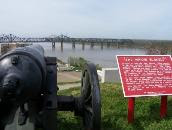 |
| Surviving Walls of Fort Cusseta, Alabama |
Newspapers across the South included a fascinating little item at the end of January, 1861. A free black barber in Columbus, Georgia, had extended an offer to raise a company of free blacks to fight in the service of his state:
Joe Clark, a colored barber of this city, has written a letter to Gov. Brown, offering to raise a company of free colored men, to be enlisted in the service of the State of Georgia in the present crisis. Whatever may be thought of the policy of enlisting soldiers of this cast, the offer is a patriotic one, and ought to show the "philanthropists" of the North that the free colored population of the South do not appreciate their efforts in behalf of the negro race. Joe served in the Indian war of 1836, and still limps occasionally from a wound received in that campaign. - Columbus Enquirer, January 1861.
Although the topic of black Confederate soldiers is quite controversial today, there was actually a long-standing tradition of military service by free blacks and slaves as well to their home states in the South during the years before the Civil War. Numerous Southern blacks had served in the American Revolution and Andrew Jackson had gladly accepted the services of Louisiana's free blacks at the Battle of New Orleans in the War of 1812. In fact, he had stood in their behalf and ordered that they be paid at the same rate as his white soldiers, something the Union did not do for its black troops for much of the Civil War.
While Clark's offer was not accepted by Governor Joseph E. Brown of Florida, the note of his service in the "Indian war of 1836" is quite interesting. The conflict in question was the Creek War of 1836, fought when the Yuchi branch of the Lower Creeks launched attacks on both whites and blacks in Alabama and Georgia in a desperate last stand against their forced removal to what is now Oklahoma on the Trail of Tears.
Numerous white citizens and slaves were killed in attacks at locations across the region, most notably at the Roanoke Massacre in Stewart County, Georgia. Both whites and blacks, including free blacks like Joe Clark, served in the fighting along with many of the Creeks themselves. This mixed race force eventually prevailed over the outnumbered Yuchi and Lower Creeks, most of whom were captured while those who were not were either killed or driven into the swamps and eventually across the line into Florida.
Uniquely, a surviving log fort of the Creek War still stands in the small community of Cusseta, Alabama, not far from Clark's home city of Columbus, Georgia. To learn more about it, please visit www.exploresouthernhistory.com/fortcusseta.









